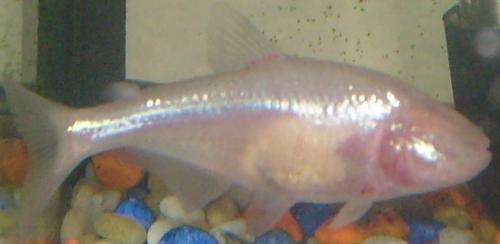April 7, 2014 report
Researchers find blind fish use novel type of navigational aid

(Phys.org) —A team of researchers at Tel Aviv University in Israel has discovered a previously unknown navigational aid used by a species of blind fish. In their paper published in the Journal of Experimental Biology, the team describes how they discovered that a blind species of tetra uses mouth suction of water to create a pressure wave that it then uses to sense objects in the water around it.
Scientists have known for many years that fish have sensors on their flanks that allow them to feel what is going on in the water in which they are immersed. Now it appears that tetras living in a cave in Mexico have added to the sensory information they receive by causing changes to water pressure around them.
The tetras are still the same species as the brightly colored fish found in aquariums across the globe, but because they've lived in absolute darkness for so long, they've lost both their coloring and their eyes. They don't need either in their caves, as they live by eating bat droppings that fall into the water. But they also do something that has never been observed in any fish—they open and close their mouths, sucking in water which is pushed out the gills, and use the changes in water pressure created to help them recognize objects around them.
Suspecting that something different was going on with the sucking motion the fish made, the researchers captured several samples and brought them back to their lab for study. There they put the fish in a tank with no food, but which did have five objects in it that the fish had to get around. After the fish became acclimated, the researchers moved the objects and then watched as the fish went to work. They noted that the fish suddenly began performing their sucking motion three and a half times more often. They followed up that experiment with another where they filmed the fish with a high-speed camera to help them count mouth action. They found that the fish very seldom sucked at the water when swimming at a distance from objects, or the wall. But when they came closer than 7 centimeters, the sucking frequency suddenly picked up, and when they moved to within just 1 centimeter, the sucking frequency occurred twice as often. It picked up again when moving even closer—up to six times as often.
The researchers suggest that the novel type of navigational aid likely occurs in other fish as well, just none that are known right now.
More information: Mexican blind cavefish use mouth suction to detect obstacles, Journal of Experimental Biology, First posted online March 27, 2014. DOI: 10.1242/jeb.098384
Abstract
Fishes commonly use their lateral line system to detect moving bodies such as prey and predators. A remarkable case is the Mexican blind cavefish Astyanax fasciatus who evolved the ability to detect non-moving obstacles. The swimming body of A. fasciatus generates fluid disturbances, whose alteration by an obstacle can be sensed by the fish's lateral line system. It is generally accepted that these alterations can provide information on the distance to the obstacle. We observed that A. fasciatus swimming in an unfamiliar environment open and close their mouths at high frequency (0.7-4.5 Hz), in order to generate suction flows. We hypothesized that repeated mouth suction generate a hydrodynamic velocity field, whose alterations by an obstacle induce pressure gradients in the neuromasts of the lateral line, and corresponding strong lateral line stimuli. We observed that the frequency and rates of mouth opening events varied with the fish's distance to obstacles, a hallmark of pulse-based navigation mechanisms such as echolocation. We formulated a mathematical model of this hitherto unrecognized mechanism of obstacle detection and parameterized it experimentally. This model suggests that suction flows induce lateral line stimuli that are weakly dependent on the fish's speed, and may be an order of magnitude stronger than the correspondent stimuli induced by the fish's gliding body. We illustrate that A. fasciatus can navigate non-visually using a combination of two deeply ancestral and highly conserved mechanisms of ray-finned fishes: the mechanism of sensing water motion by the lateral line system and the mechanism of generating water motion by mouth suction.
Journal information: Journal of Experimental Biology
© 2014 Phys.org


















